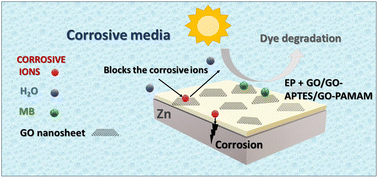Correlations between the anti-corrosion properties and the photocatalytic behavior of epoxy coatings incorporating modified graphene oxide deposited on a zinc substrate†
Abstract
This research aimed to create a substrate-coating system based on zinc and an epoxy resin incorporating modified graphene oxide, which possesses two key characteristics: effective resistance against corrosion and the ability to harness photocatalytic properties. Furthermore, correlations between the anti-corrosion properties and the photocatalytic behaviour of the coatings were made. Thin epoxy (EP) layers embedding 0.1 wt% graphene oxide (GO), reduced graphene oxide (rGO), and modified graphene oxide with (3-aminopropyl)-triethoxysilane (APTES) or poly(amidoamine) (PAMAM) dendrimer were applied on a zinc (Zn) substrate using the dip-coating method. Anti-corrosion properties of coated Zn samples were investigated through electrochemical impedance spectroscopy (EIS) measurements. They showed that the corrosion protection effect is more prominent for EP containing functionalized GO, the highest in the case of GO-PAMAM. The results of the EIS measurements indicated also that the corrosion protection provided by EP-rGO is smaller than that of EP. The photocatalytic properties of the coatings were studied by exposure of the samples to Methylene Blue (MB) solution followed by monitoring the model dye degradation through UV-Vis measurements. To determine the changes in the anti-corrosion properties due to photocatalysis, the coated Zn samples were put through additional EIS measurements. The same coatings applied to a glass substrate lacked photocatalytic properties, indicating that the Zn substrate is accountable for the degradation of MB. Furthermore, the incorporation of GO or functionalized GO into the coating amplifies this effect. From EIS spectra, it was determined that the protective properties loss observed after 3 days is due to coating delamination during exposure to MB solution, the EP-GO-APTES retaining the best adhesion of the coating, 98% remaining on Zn after a cross-hatch test. The corrosion measurements were complemented by examining the morphology and structure of the coatings and the modified GO particles. All things considered, the Zn/EP-GO-APTES system shows the best ability to break down organic pollutants, keeping a good anti-corrosive property and adhesion.



 Please wait while we load your content...
Please wait while we load your content...